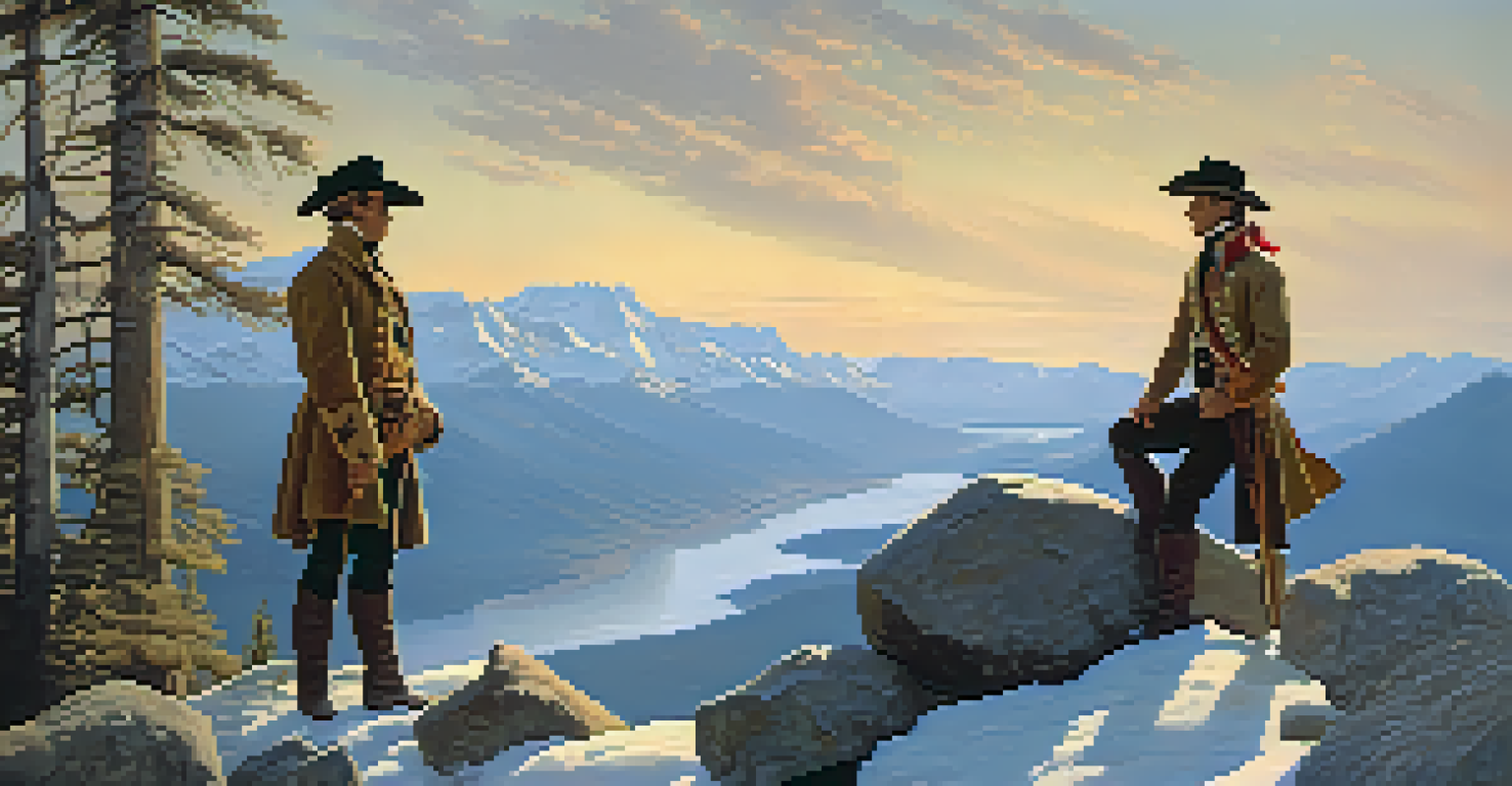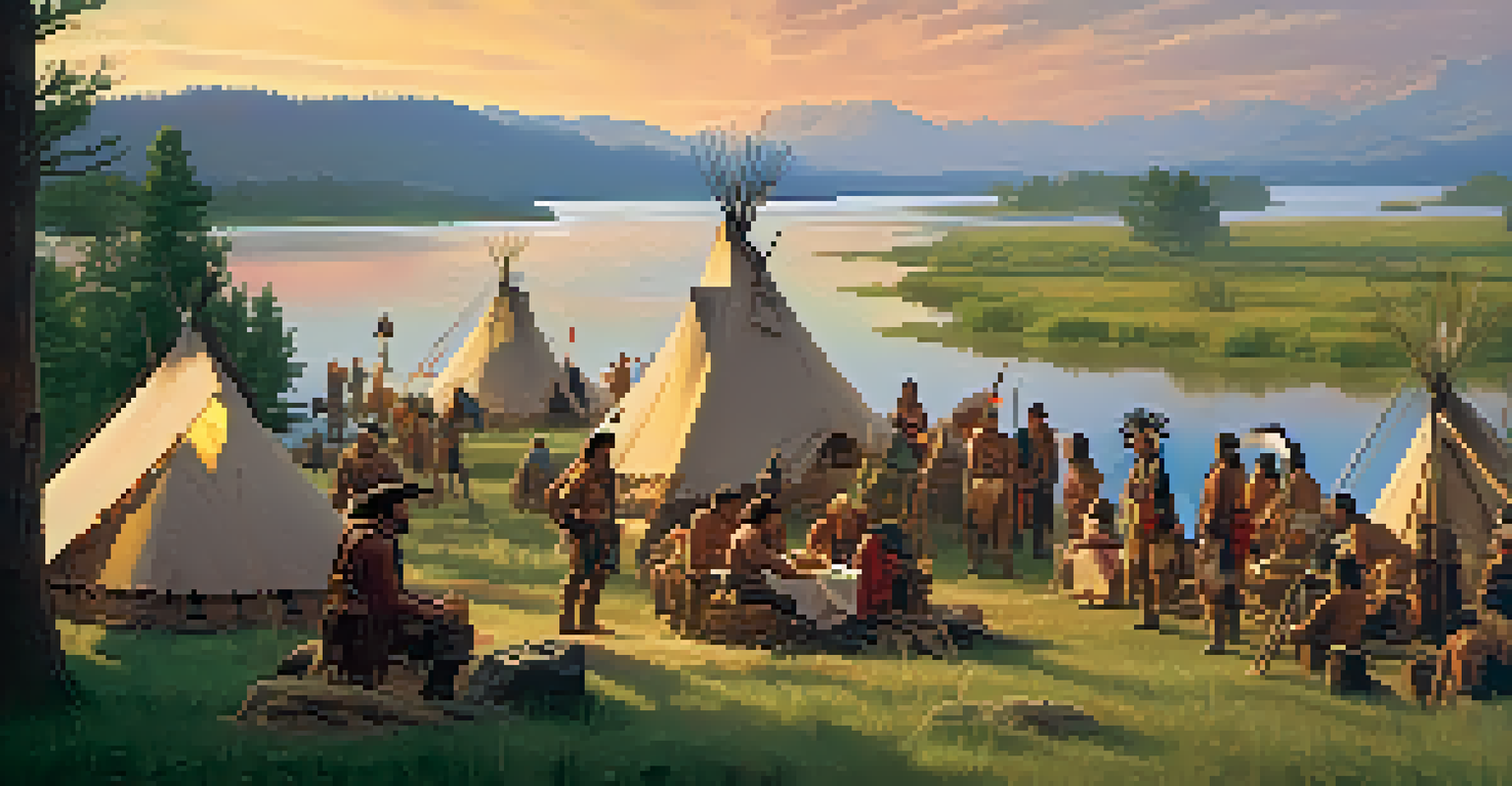The Lewis and Clark Expedition: Mapping America's Heartland

Introduction: The Genesis of the Expedition
The Lewis and Clark Expedition, commissioned by President Thomas Jefferson in 1803, aimed to explore the newly acquired Louisiana Territory. This monumental journey was not just about mapping terrain; it was also about establishing American presence and understanding the vast lands that stretched westward. Jefferson's vision was to find a navigable route to the Pacific Ocean, which could enhance trade and expand the nation’s influence.
The West is a place of hope and adventure, where the mysteries of the land await those brave enough to explore them.
The expedition was led by Meriwether Lewis and William Clark, who handpicked a diverse team of soldiers, explorers, and interpreters. Their mission was ambitious and fraught with uncertainty, as they set out with limited knowledge of the lands they would traverse. With journals in hand, they aimed to document everything from the geography to the flora and fauna they encountered along the way.
As they prepared to embark in May 1804, the team was filled with a mix of excitement and trepidation. Little did they know that their journey would become a pivotal chapter in American history, shaping the nation’s understanding of its heartland and laying the groundwork for future exploration.
Setting Sail: The Journey Begins
The expedition kicked off from St. Louis, Missouri, where the Missouri River flows majestically. This river would serve as their primary route, guiding them through the heart of the continent. The team traveled in canoes and later on foot, navigating the challenges posed by the unpredictable river and rugged terrain.

As they journeyed, the group faced various obstacles, including harsh weather, treacherous rapids, and encounters with Indigenous tribes. Each day brought new challenges, but also new opportunities for learning and connection. The expedition's members, particularly Lewis and Clark, took detailed notes about the landscapes and people they encountered, highlighting the rich diversity of the American West.
Exploration of the Louisiana Territory
The Lewis and Clark Expedition aimed to explore the vast Louisiana Territory, documenting its geography, flora, and fauna while establishing American presence.
The spirit of adventure propelled them forward, and the excitement of discovery became their daily motivation. Each mile traveled deepened their understanding of this vast, uncharted territory, and they became more determined to reach the Pacific coast.
Encounters with Native Tribes
One of the most significant aspects of the Lewis and Clark Expedition was their interaction with Native American tribes. The explorers encountered various groups, including the Mandan, Hidatsa, and Nez Perce, each with their own unique cultures and traditions. These interactions were crucial, as the expedition relied on the tribes for guidance, supplies, and knowledge of the land.
Exploration knows no bounds; it is the spirit of humanity to seek, discover, and understand the unknown.
While some tribes welcomed the explorers and assisted them, others were wary of these newcomers encroaching on their territory. The interactions were complex; they often included trade but also moments of tension. Lewis and Clark made it a point to record these experiences, as they understood the importance of these relationships for future American expansion.
These encounters fostered a better understanding of the diverse cultures that existed in America before widespread settlement. The expedition members learned to appreciate the tribes' deep connection to the land, which contrasted with the American vision of expansion and development.
Challenges and Triumphs Along the Way
The journey was fraught with numerous challenges, from health issues to food shortages. The expedition faced grueling conditions, with harsh climates and rugged landscapes testing their endurance. Yet, through these trials, the team showed remarkable resilience, adapting to their circumstances as they pressed on toward their goal.
One of the most notable challenges was crossing the Rocky Mountains, a daunting task that required both physical and mental fortitude. The team utilized their skills in navigation and survival, often relying on the guidance of Native American tribes who had long traversed these mountains. This segment of the journey solidified their reputation as skilled explorers.
Interactions with Native Tribes
The expedition's encounters with various Native American tribes were crucial for guidance and resources, highlighting the complex relationships between explorers and Indigenous peoples.
Despite the hardships, the expedition also celebrated many triumphs, including the discovery of new species and breathtaking landscapes. Each success fueled their determination, reminding them why they embarked on this ambitious quest in the first place.
Reaching the Pacific: A Historic Milestone
After more than two years of arduous travel, the Lewis and Clark Expedition finally reached the Pacific Ocean in November 1805. This monumental achievement not only fulfilled President Jefferson’s vision but also marked a significant moment in American history. Standing on the shores of the ocean, the team felt a mix of exhaustion and elation at having completed their journey.
The expedition took time to document their findings, from the coastal geography to the local wildlife. They also established relationships with Indigenous groups in the region, further expanding their understanding of the diverse cultures they encountered. These notes and sketches would later become invaluable resources for future explorers and settlers.
Reaching the Pacific was not just an end point; it symbolized the vast possibilities that lay ahead for the young nation. The team’s success ignited a spirit of exploration that would resonate throughout America for generations to come.
The Return Journey: New Discoveries Await
The return journey back to St. Louis began in March 1806, filled with a sense of accomplishment but also the weight of the challenges ahead. The expedition had gathered immense knowledge about the lands they traversed, but now they had to navigate back through the same rugged terrain. The experience had changed them, making them not just explorers but also ambassadors of their findings.
During the return trip, the team continued to document their discoveries and experiences, noting changes in the landscape and wildlife as they made their way back. They also reflected on their interactions with various tribes, understanding the importance of these relationships for future American expansion. Each encounter enriched their understanding of the lands they were crossing once again.
Impact on American Expansion
The expedition's findings sparked interest in the West, influencing future exploration and shaping American policy towards Native tribes.
As they neared their destination, the sense of urgency grew. They were not just returning as explorers; they were coming back as storytellers, ready to share their remarkable journey with the rest of the world.
Legacy of the Lewis and Clark Expedition
The impact of the Lewis and Clark Expedition extended far beyond their journey. Upon their return in 1806, the explorers shared their findings with the American public, sparking interest in the West and paving the way for future exploration and settlement. Their detailed maps and journals became essential resources for those who followed in their footsteps.
The expedition also played a crucial role in shaping American policy towards Native American tribes. While it highlighted the richness of the land, it also underscored the urgent need for respectful and meaningful relationships with Indigenous peoples. Understanding these dynamics remains relevant today as discussions around land rights and cultural preservation continue.

Ultimately, the legacy of Lewis and Clark is one of exploration, discovery, and the complex interplay between cultures. Their journey is a reminder of the spirit of adventure that drives humanity to explore the unknown, and it continues to inspire future generations to seek knowledge and understanding.